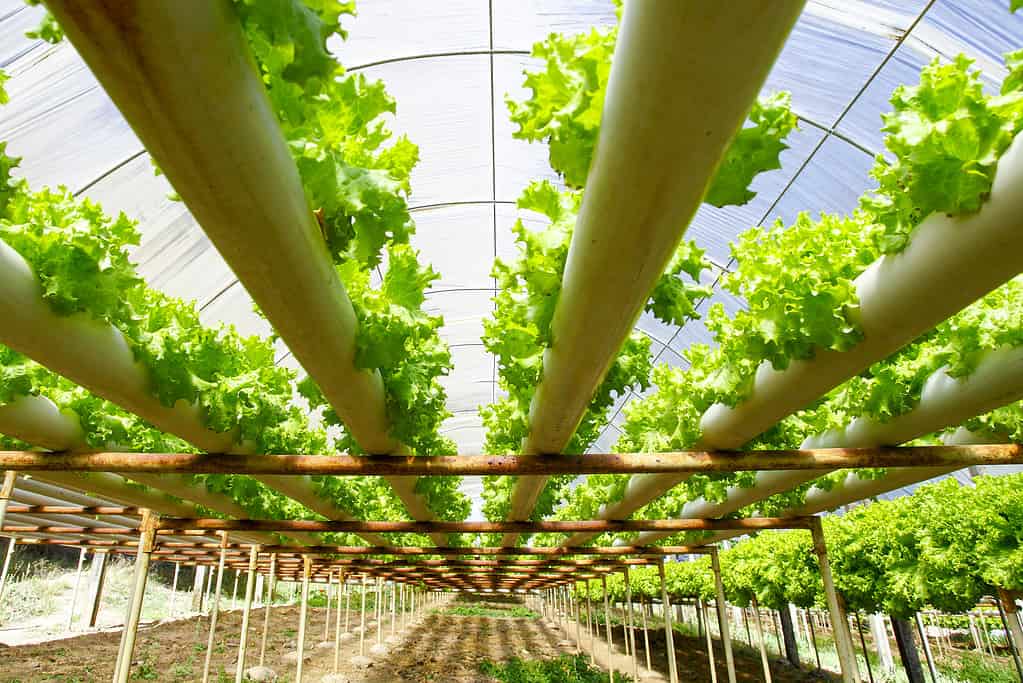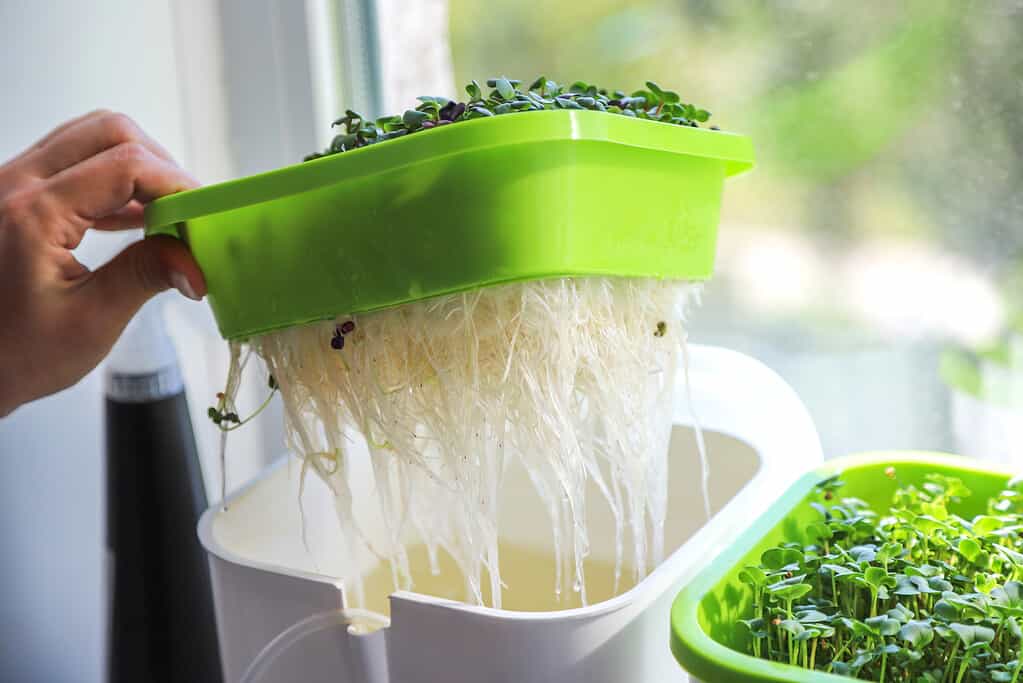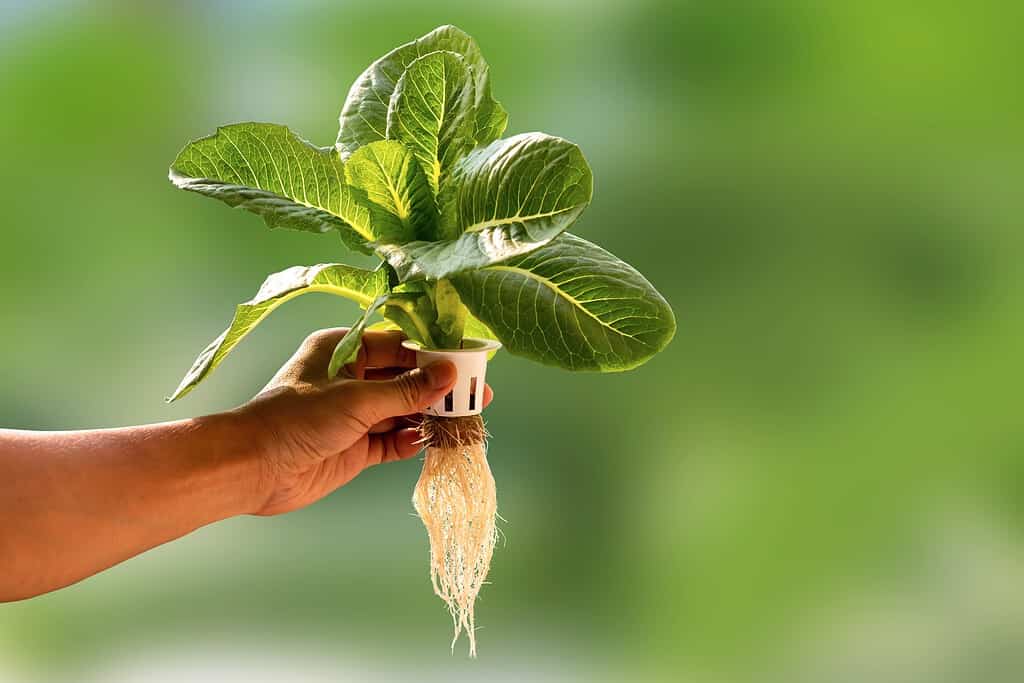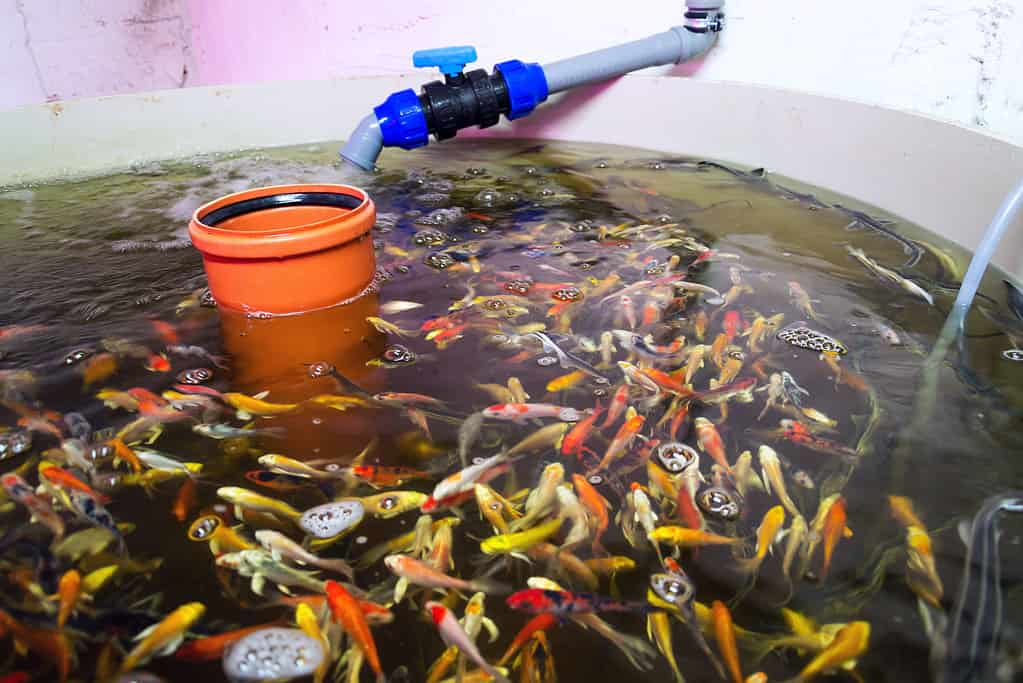Who says you need a large space or even soil to grow plants? There are so many different growing systems out there, each with its benefits! Two popular growing systems, that don’t use messy dirt are aquaponics and hydroponics. The systems are very similar and primarily use water and plant nutrients, however, aquaponics has something special, fish! Follow along to learn the similarities and differences between aquaponics vs. hydroponics.
The Differences Between Aquaponics vs. Hydroponics
Aquaponic and hydroponic systems have few differences, but these differences can complicate things depending on your wants and needs. For example, it’s easier to operate a hydroponics system in a small space, like an apartment. This, however, is a bit more difficult when maintaining an aquaponics system. Follow along to learn the key operational, nutrient management, plant growth, and health, and general maintenance and practical considerations.

Hydroponics is a growing system that uses water and plant nutrients.
©ribeirorocha/iStock via Getty Images
Operational Differences
Aquaponics
Aquaponics is a unique system that combines aquaculture and hydroponics. Aquaculture is the cultivation of fish and other aquatic animals or plants. It’s sometimes also called fish farming or fish culturing.
There are multiple ways to build a system, but they all generally work the same. The fish eat and produce fish waste, ammonia, which is then converted into nitrates using nitrifying bacteria. The nitrates act as a strong fertilizer, which is fed to the plants. The plants then filter the water, which goes back to the fish tank.
Usually, the system is built on layers. For instance, at the bottom of the aquaponics system is a tank with fish. You can use different species including beta, largemouth bass, tilapia, perch, and salmon. Then is a section for water filtration. Pipes push filtered water back to the top layer, which is where the plants grow. This water then drops down to the fish again.
The top layer is what changes the most depending on the design. Some people use a large grow bed with clay rocks or some kind of grow material that mimics soil. Others only use water. You can also the Dutch bucket system, which is perfect for vining plants.

Aquaponic systems vary a lot, but generally, the fish are at the bottom, and the plants are on top.
©Dzikri Septian/iStock via Getty Images
Hydroponics
The biggest operational and design difference between an aquaponics system and a hydroponics system is that hydroponics uses only plant nutrients, not fish. Hydroponic systems are more flexible. You can purchase systems online or make your own. Some of the systems grow under LED grow lights on a flat board, with their roots submerged under water. Some systems use vertical growing techniques which can save you a lot of space. You can also use PCP pipes to design your system. Hydroponics works well indoors, outdoors, and in greenhouses.
In a hydroponics system, the most important components include plant nutrients, a growing medium (not soil), water, and a water pump. Some hydroponics systems also use an air pump, air stone, timer, grow lights, and nutrient pump. You can make it as simple or as complex as you’d like!
Nutrient Management
Aquaponics
Plants receive nutrients from fish waste in aquaponics systems. However, sometimes the waste is not enough. It’s also important for the water to remain at the right pH level as some fish species, specifically goldfish and beta fish are sensitive. It’s also vital you choose a high-quality fish feed with macro-nutrients and micro-nutrients. Common nutrient deficiencies within this type of system include iron, magnesium, potassium, nitrogen, calcium, and phosphorous. Interestingly, the schedule in which the fish are fed also contributes to the plant’s health. According to a study, the best feeding regime is a uniform one. It improves water quality.
Hydroponics
Hydroponics systems, unlike aquaponics, don’t rely on nutrients from fish and fish feed. Instead, hydroponic systems need plant food in a specific ratio depending on the amount of water in a system. Nutrients your system and plant will need are nitrogen, sulfur, calcium, potassium, magnesium, and phosphorous. You can either purchase an already mixed nutrient mix or food nutrients you can mix with water and combine in a system. As the water levels drop, you add more.

Many plants grow best in hydroponics and aquaponics systems. Microgreens are common plants to grow in aquaponics systems.
©Ekaterina Markelova/iStock via Getty Images
Plant Growth and Health
Growing plants in an aquaponics system is very easy and worthwhile. Generally, plants grow faster in both hydroponics and aquaponics systems. This is because the plants have access to nutrients at all times. Lettuce grown in soil can take between 30 to 70 days. In hydroponics and aquaponics systems, the growing time for lettuce can be cut nearly in half.
There are very few differences in the health of plants growing in both systems. You can grow anything from flowers, vegetables, fruits, and herbs. Popular plants in both systems include cilantro, parsley, catnip, tomatoes, peppers, basil, mint, cucumbers, and strawberries.

Leafy greens grow well in hydroponic systems.
©Thanongsak Sukjai/iStock via Getty Images
Maintenance and Practical Considerations
Aquaponics
Maintaining an aquaponics system takes time, patience, and money. It’s very important to maintain a regular pH level. A spike or drop can harm the fish, and even kill them. Not only should you monitor pH levels, but also the water level. This is the main difference between maintaining an aquaponics vs. hydroponics system.
But, are aquaponics systems practical? There are a lot of benefits to using an aquaponics system. However, they can be difficult to maintain and store in a small space. Aquaponics is great if you have a home with good ventilation. Trying to create or purchase a large aquaponics system in an apartment is challenging, although not entirely impossible. However, the lack of air circulation can lead to diseases and mold. Still, you can use an aquaponics system on a small scale in a small space. There are kits perfect for small fish like goldfish or beta fish. Aquaponics systems cost a little more than hydroponics systems, but the cost range varies a lot. You can create your system for as little as $30 or buy a professional, already-installed system for over $1,000.

Aquaponic systems combine aquaculture with hydroponics. You can use many different fish species in these systems including bass, tilapia, and goldfish.
©josefkubes/iStock via Getty Images
Hydroponics
Hydroponics systems aren’t too difficult to maintain. A similarity between both systems though is that regular cleaning is necessary, especially the grow bed. Over time, even with the air pump running and a fan for air circulation, the grow bed can develop mold and algae. Sometimes, mold also grows on the growing medium. This is common when there isn’t enough air circulation and mainly happens with indoor systems. One way to combat this is by using a small fan to provide air flow and to wrap the growing medium in aluminum foil, apart from the center for the seed to emerge.
It’s time to clean your system when you’ve harvested multiple times and want to start a new set of plants. Starting seeds immediately is not recommended as organic matter, like plant roots, can remain in the water. First, start by pouring the water out of the system. Specific cleaning instructions vary depending on the type of system. You need to sanitize and sterilize the system before restarting it with new plants. After pouring the water, wipe down the grow bed and take out any remaining roots. Water and wiping aren’t enough though. You will need to use soap and either bleach or a food-grade hydrogen peroxide mix. To get all the nooks and crannies, it’s best to use a brush when cleaning. Only use bleach though when you’re completely restarting the system, not when completing a simple cleaning.
These convenient systems are very practical, even with their maintenance requirements. They are easy to use in small and large spaces. Aquaponics systems aren’t too different but require more responsibility as live animals are part of the process. Hydroponics systems are better for beginners.
The photo featured at the top of this post is © sssubinpark/Shutterstock.com
Thank you for reading! Have some feedback for us? Contact the AZ Animals editorial team.







